The LoginTC RADIUS Connector is a complete two-factor authentication virtual machine packaged to run within your corporate network. The LoginTC RADIUS Connector enables the WatchGuard XTM and Firebox VPN (e.g. Mobile VPN with SSL or IPSec) to use LoginTC for the most secure two-factor authentication. For an alternate method using Challenge Response then you may be interested in: Two factor authentication for WatchGuard XTM and Firebox IPSec.
User ExperienceAfter entering the username and password into the Mobile VPN IPSec client, an authentication request is sent to the user’s mobile device using a push notification. The user simply needs to approve the request for second factor.
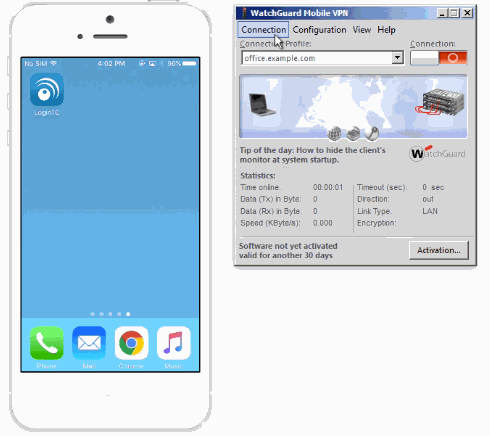
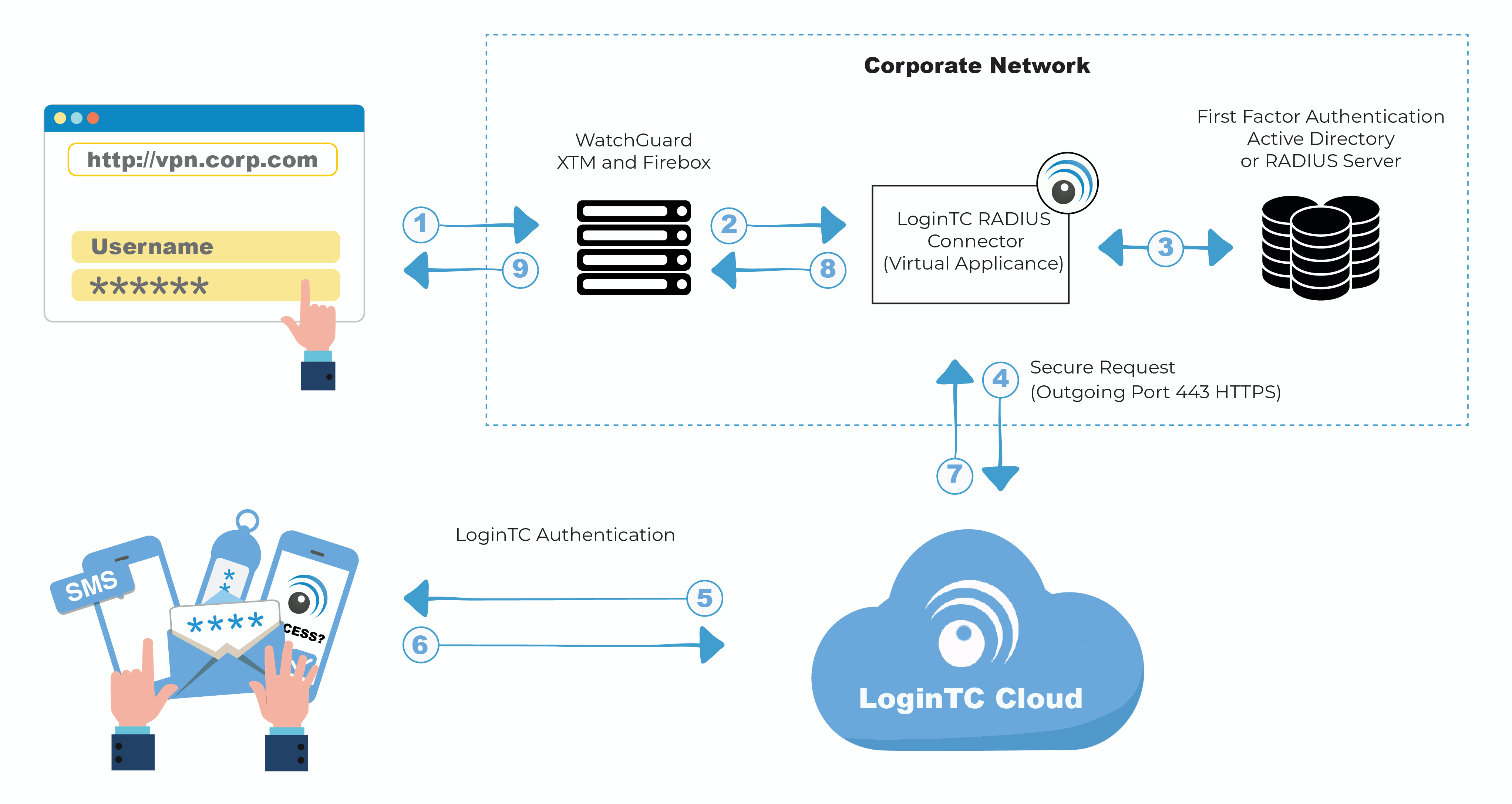
Authentication Flow
- A user attempts access with their existing WatchGuard client with username / password
- A RADIUS authentication request is sent to the LoginTC RADIUS Connector
- The username / password is verified against an existing first factor directory (LDAP, Active Directory or RADIUS)
- An authentication request is made to LoginTC Cloud Services
- Secure push notification request sent to the user’s mobile or desktop device
- User response (approval or denial of request) sent to LoginTC Cloud Services
- The LoginTC RADIUS Connector polls until the user responds or a timeout is reached
- RADIUS Access-Accept sent back to WatchGuard
- User is granted access to WatchGuard
Prefer Reading a PDF?
Download a PDF file with configuration instructions for your chosen VPN protocol:
- Get the WatchGuard XTM and Firebox VPN with LoginTC Two Factor Authentication for Mobile VPN with IPsec
- Get the WatchGuard XTM and Firebox VPN with LoginTC Two Factor Authentication for Mobile VPN with IPsec Alternative
- Get the WatchGuard XTM and Firebox VPN with LoginTC Two Factor Authentication for Mobile VPN with SSL
- Get the WatchGuard XTM and Firebox VPN with LoginTC Two Factor Authentication for Mobile VPN with SSL Alternative
WatchGuard appliance compatibility:
- WatchGuard Firebox T10 Series
- WatchGuard XTM 2 Series
- WatchGuard XTM 3 Series
- WatchGuard XTM 5 Series
- WatchGuard Unified Threat Management (UTM)
- WatchGuard Next-Generation Firewall (NGFW)
- WatchGuard appliance supporting RADIUS authentication
Appliance not listed?
We probably support it. Contact us if you have any questions.
Compatibility Guide
WatchGuard XTM, Firebox and any other appliance which have configurable RADIUS authentication supported.
Before proceeding, please ensure you have the following:
- LoginTC Admin Panel account
- Computer virtualization software such as VMware ESXi, VirtualBox, or Hyper-V
- Virtual Machine requirements:
- 1024 MB RAM
- 8 GB disk size
Start by creating a LoginTC Application for your deployment. An Application represents a service (e.g. An application is a service (e.g., VPN or web application) that you want to protect. e) that you want to protect with LoginTC.
Create a LoginTC Application in LoginTC Admin Panel, follow Create Application Steps.
If you have already created a LoginTC Application for your deployment, then you may skip this section and proceed to Installation.
Installation- Download the latest LoginTC RADIUS Connector:
- Unzip the file
- Import the virtual appliance your computer virtualization software
- Ensure that the LoginTC RADIUS Connector has a virtual network card
- Start the virtual appliance
- You will be presented with a console dashboard:
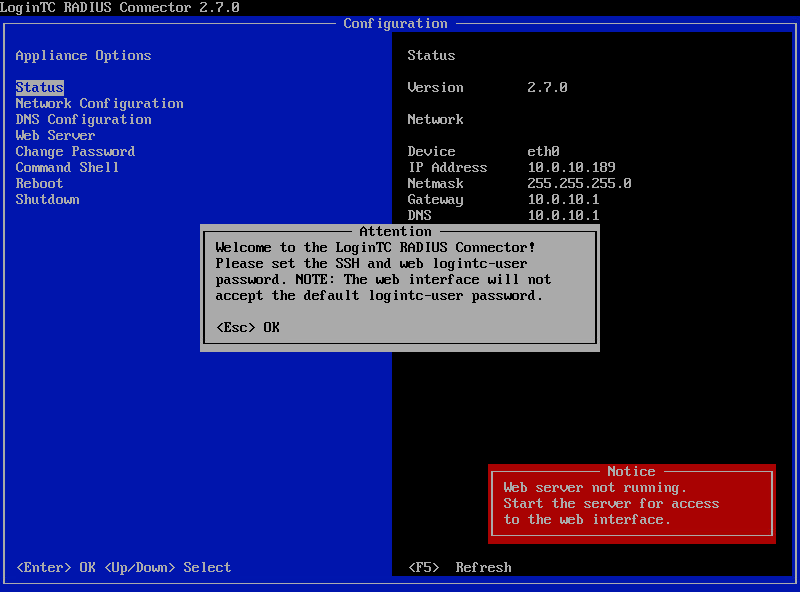
- The first thing you must do is set the
logintc-userpassword: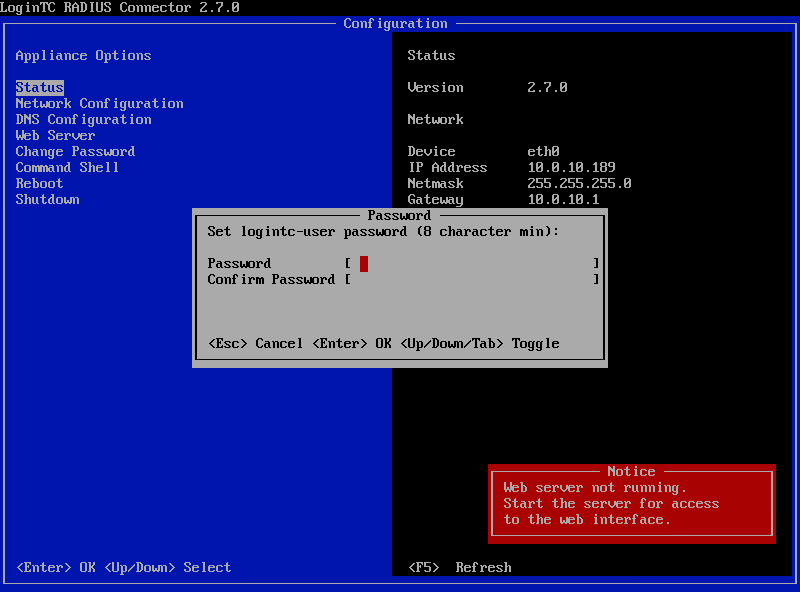
- By default the appliance network is configured by DHCP. If you wish to manually configure the network, use the Down arrow key to navigate to Network Configuration and DNS Configuration
- For access to the web interface select Web Server and then Start:
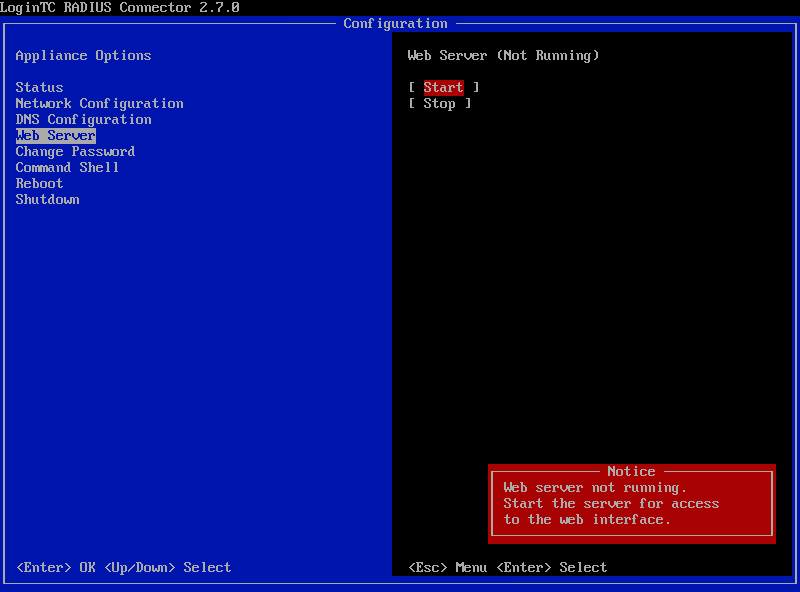 It may take 5-10 seconds to start the first time:
It may take 5-10 seconds to start the first time: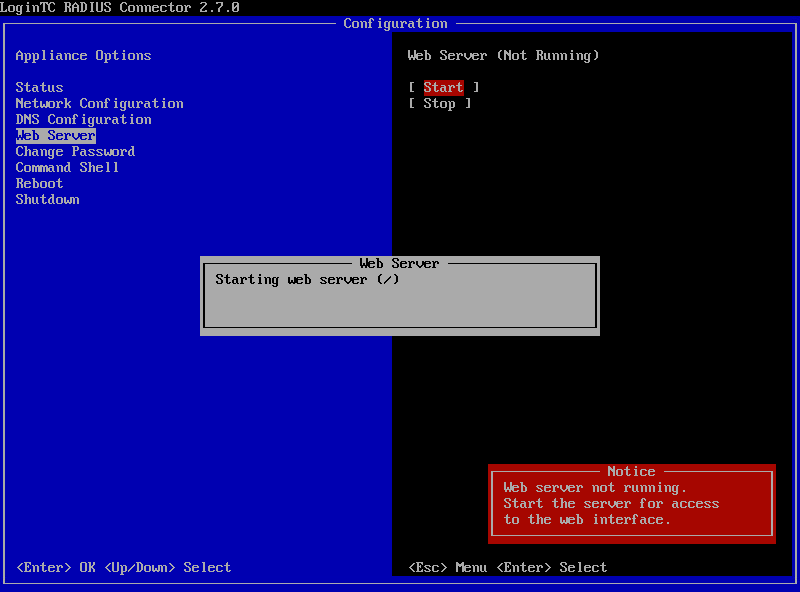
- Once started, access the web interface by navigating to the URL mentioned in the information box:
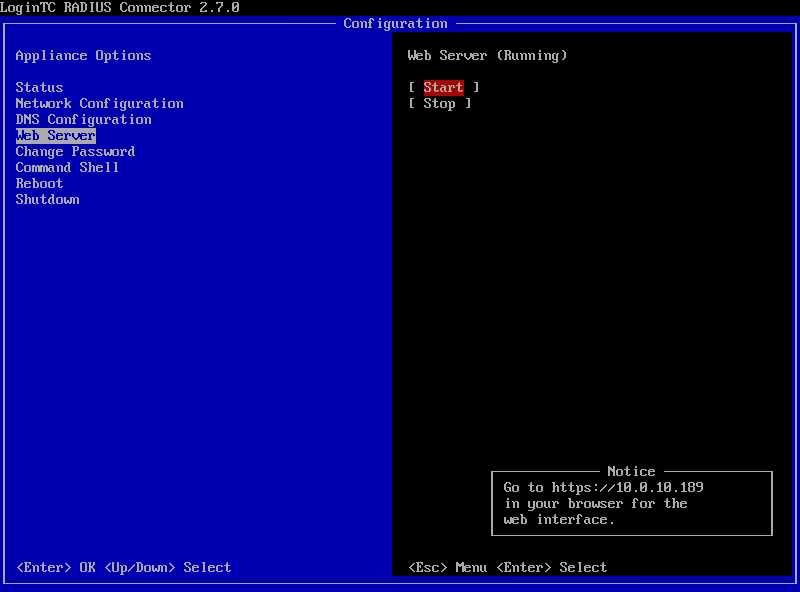
The LoginTC RADIUS Connector runs CentOS 7.7 with SELinux. A firewall runs with the following open ports:
| Port | Protocol | Purpose |
|---|---|---|
| 22 | TCP | SSH access |
| 1812 | UDP | RADIUS authentication |
| 1813 | UDP | RADIUS accounting |
| 8888 | TCP | Web interface |
| 443 | TCP | Web interface |
| 80 | TCP | Web interface |
| 80 | TCP | Package updates (outgoing) |
| 123 | UDP | NTP, Clock synchronization (outgoing) |
Note: Username and Password
logintc-user is used for SSH and web access. The default password is logintcradius. You will be asked to change the default password on first boot of the appliance and will not be able to access the web interface unless it is change.
The logintc-user has sudo privileges.
Configuration describes how the appliance will authenticate your RADIUS-speaking device with an optional first factor and LoginTC as a second factor. Each configuration has 4 Sections:
1. LoginTC
This section describes how the appliance itself authenticates against LoginTC Admin Panel with your LoginTC Application. Only users that are part of your organization and added to the domain configured will be able to authenticate.
2. First Factor
This section describes how the appliance will conduct an optional first factor. Either against an existing LDAP, Active Directory or RADIUS server. If no first factor is selected, then only LoginTC will be used for authentication.
3. Passthrough
This section describes whether the appliance will perform a LoginTC challenge for an authenticating user. The default is to challenge all users. However with either a static list or Active Directory / LDAP Group you can control whom gets challenged to facilitate seamless testing and rollout.
4. Client and Encryption
This section describes which RADIUS-speaking device will be connecting to the appliance and whether to encrypt API Key, password and secret parameters.
Data Encryption
It is strongly recommended to enable encryption of all sensitive fields for both PCI compliance and as a general best practice.
The web interface makes setting up a configuration simple and straightforward. Each section has a Test feature, which validates each input value and reports all potential errors. Section specific validation simplifies troubleshooting and gets your infrastructure protected correctly faster.
First Configuration
Close the console and navigate to your appliance web interface URL. Use username logintc-user and the password you set upon initial launch of the appliance. You will now configure the LoginTC RADIUS Connector.
Create a new configuration file by clicking + Create your first configuration:
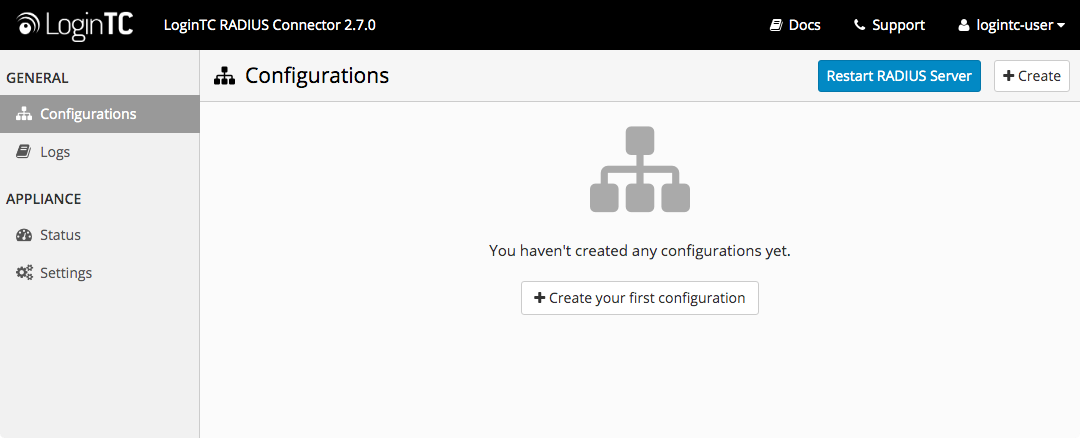
LoginTC Settings
Configure which LoginTC Application to us:
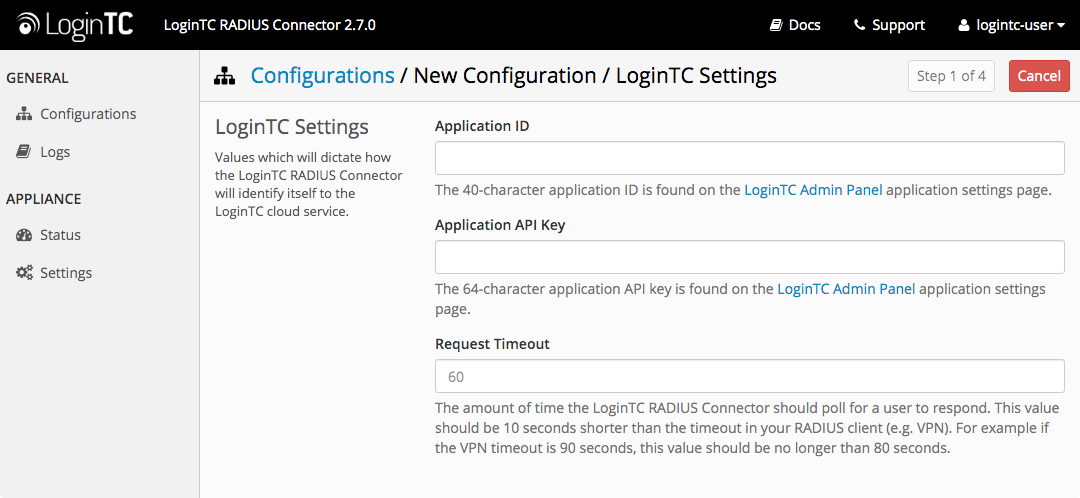
Configuration values:
| Property | Explanation |
|---|---|
Application ID |
The 40-character Application ID, retrieve Application ID |
Application API Key |
The 64-character Application API Key, retrieve Application API Key |
Request Timeout |
Number of seconds that the RADIUS connector will wait for |
The Application ID and Application API Key are found on the LoginTC Admin Panel.
Request Timeout
Make a note of what you set the Request Timeout to as you will need to use a larger timeout value in your WatchGuard. We recommend setting the Request Timeout value to 60 seconds in the LoginTC RADIUS Connector and setting the RADIUS authentication server timeout to 70 seconds in WatchGuard.
Click Test to validate the values and then click Next:
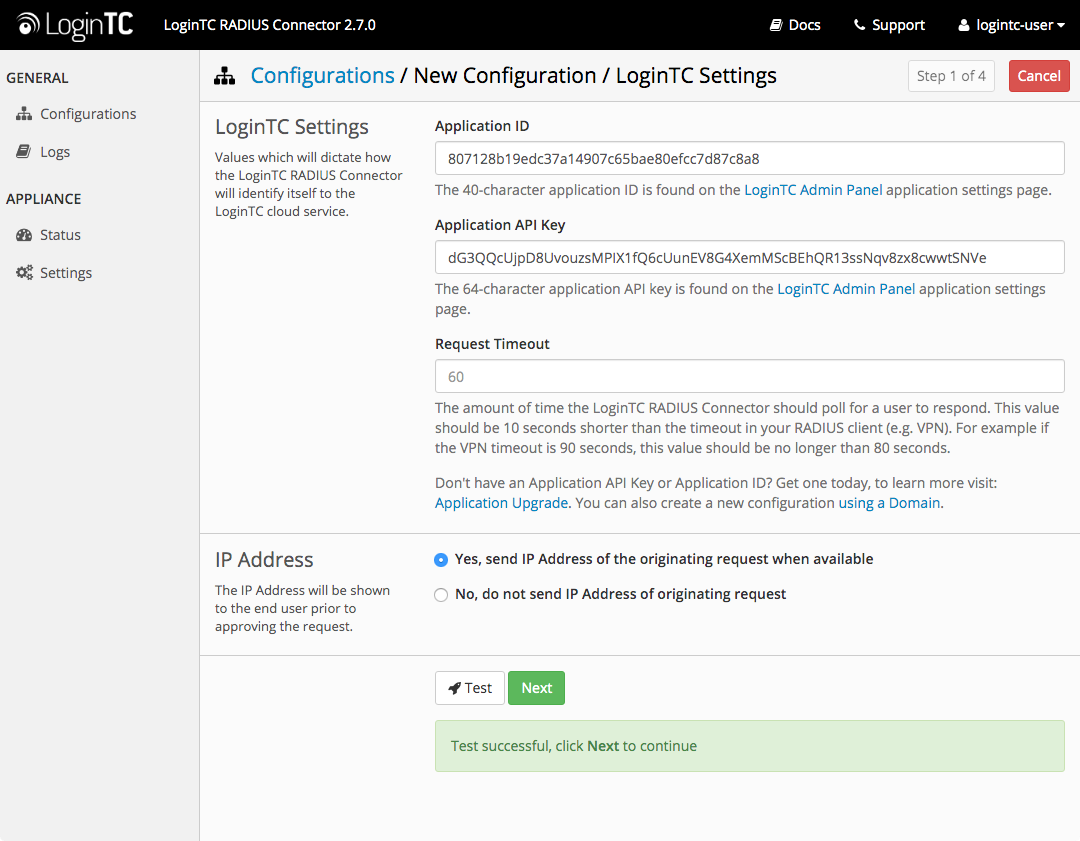
First Authentication Factor
Configure the first authentication factor to be used in conjunction with LoginTC. You may use Active Directory / LDAP or an existing RADIUS server. You may also opt not to use a first factor, in which case LoginTC will be the only authentication factor.
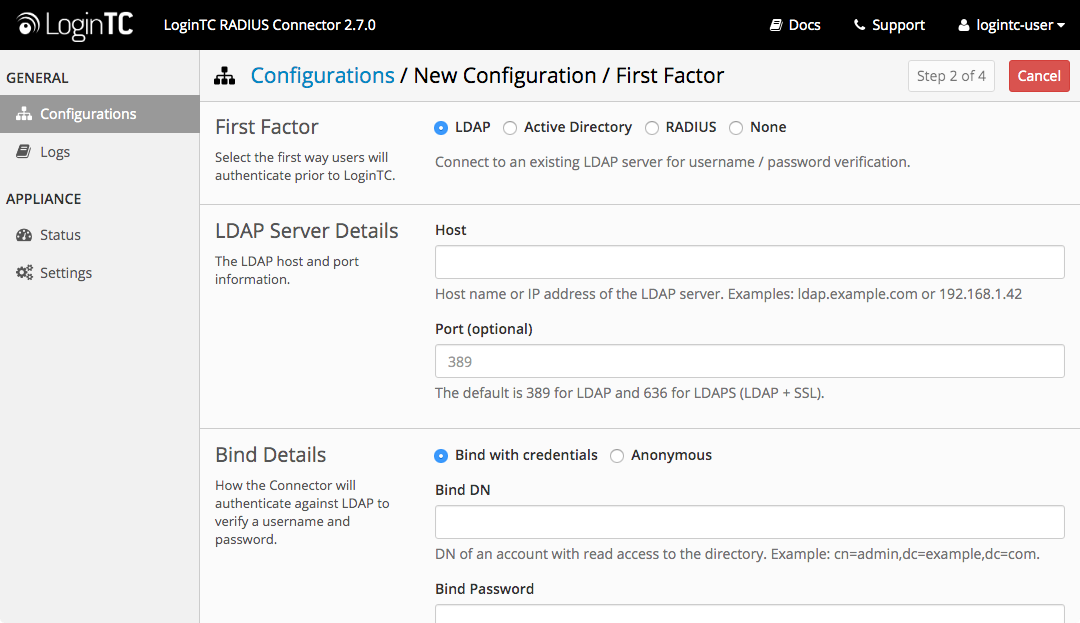
Active Directory / LDAP Option
Select Active Directory if you have an AD Server. For all other LDAP-speaking directory services, such as OpenDJ or OpenLDAP, select LDAP:
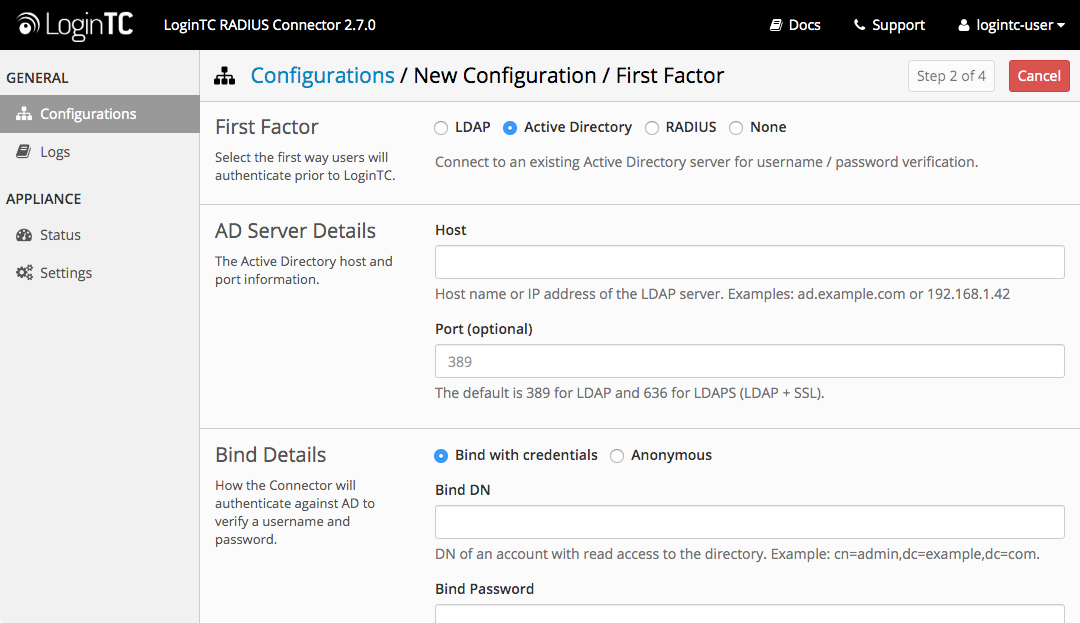
Configuration values:
| Property | Explanation | Examples |
|---|---|---|
host |
Host or IP address of the LDAP server | ldap.example.com or 192.168.1.42 |
port (optional) |
Port if LDAP server uses non-standard (i.e., 389/636) |
4000 |
bind_dn |
DN of a user with read access to the directory | cn=admin,dc=example,dc=com |
bind_password |
The password for the above bind_dn account | password |
base_dn |
The top-level DN that you wish to query from | dc=example,dc=com |
attr_username |
The attribute containing the user’s username | sAMAccountName or uid |
attr_name |
The attribute containing the user’s real name | displayName or cn |
attr_email |
The attribute containing the user’s email address | mail or email |
Group Attribute (optional) |
Specify an additional user group attribute to be returned the authenticating server. | Office VPN |
RADIUS Group Attribute (optional) |
Name of RADIUS attribute to send back | Filter-Id |
LDAP Group / AD Group (optional) |
A comma delimited list of the names of possible LDAP groups to be sent back to the authenticating server. The user must be a member of a group for the attribute to be sent back. Groups membership is checked in priority order, if the user is a member of multiple groups the first group matched is returned. | Office VPN or Administrators,Sales,Engineers |
encryption (optional) |
Encryption mechanism | ssl or startTLS |
cacert (optional) |
CA certificate file (PEM format) | /opt/logintc/cacert.pem |
Group Attribute and Access Control
In order to use Mobile VPN with IPSec, you must properly configure the Group Attribute in your RADIUS Connector. WatchGuard devices use the Group Attribute value to set the attribute that carries the User Group information. This information is used for access control.
LDAP Group / AD Group : The name of a group in the LDAP Directory that all authenticating users belong to. The group name must match exactly the Mobile VPN with IPSec group profile name.
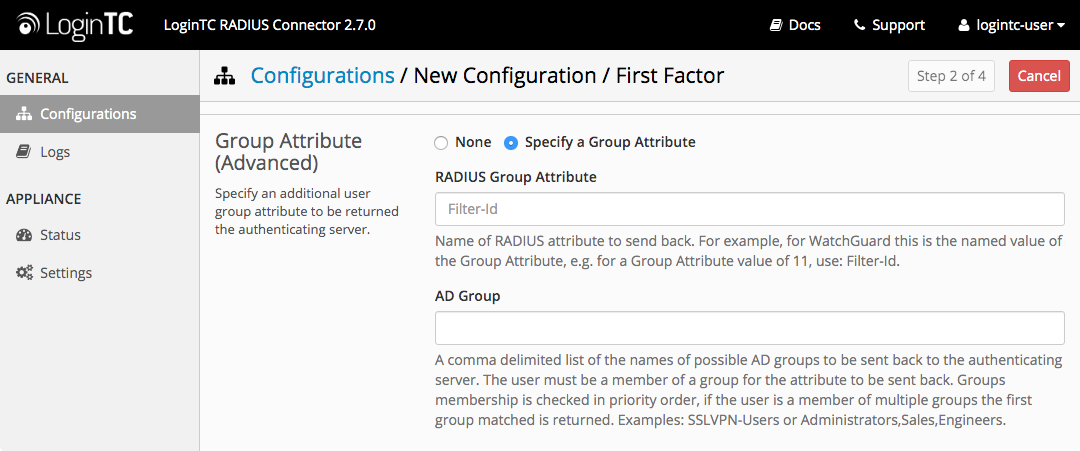
Click Test to validate the values and then click Next.
Existing RADIUS Server Option
If you want to use your existing RADIUS server, select RADIUS:
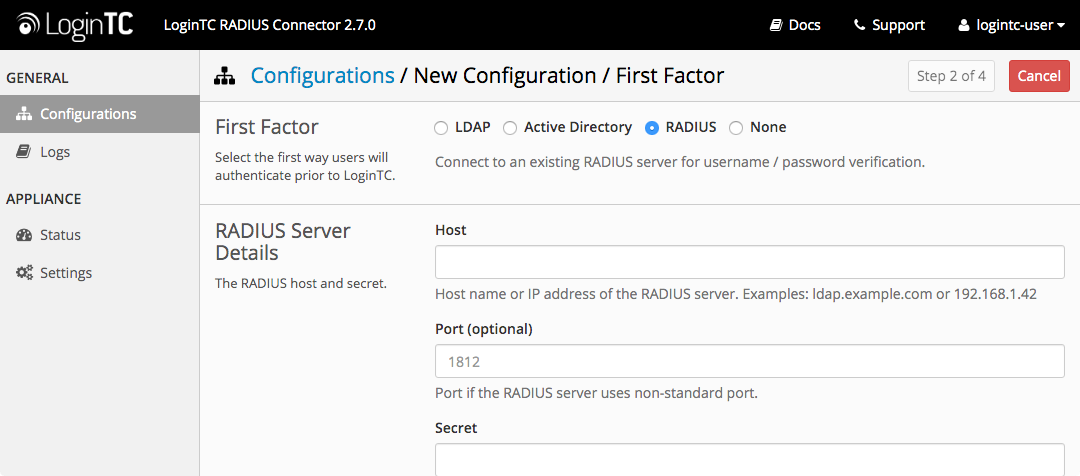
Configuration values:
| Property | Explanation | Examples |
|---|---|---|
host |
Host or IP address of the RADIUS server | radius.example.com or 192.168.1.43 |
port (optional) |
Port if the RADIUS server uses non-standard (i.e., 1812) |
1812 |
secret |
The secret shared between the RADIUS server and the LoginTC RADIUS Connector | testing123 |
RADIUS Vendor-Specific Attributes
Common Vendor-Specific Attributes (VSAs) found in the FreeRADIUS dictionary files will be relayed.
Click Test to validate the values and then click Next.
Passthrough
Configure which users will be challenged with LoginTC. This allows you to control how LoginTC will be phased in for your users. This flexibility allows for seamless testing and roll out.
For example, with smaller or proof of concept deployments select the Static List option. Users on the static list will be challenged with LoginTC, while those not on the list will only be challenged with the configured First Authentication Factor. That means you will be able to test LoginTC without affecting existing users accessing your VPN.
For larger deployments you can elect to use the Active Directory or LDAP Group option. Only users part of a particular LDAP or Active Directory Group will be challenged with LoginTC. As your users are migrating to LoginTC your LDAP and Active Directory group policy will ensure that they will be challenged with LoginTC. Users not part of the group will only be challenged with the configured First Authentication Factor.
No Passthrough (default)
Select this option if you wish every user to be challenged with LoginTC.
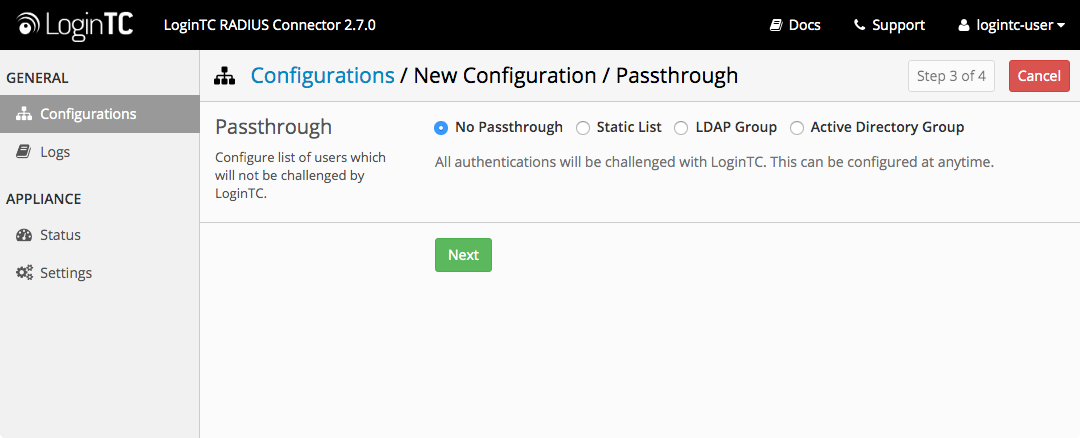
Static List
Select this option if you wish to have a static list of users that will be challenged with LoginTC. Good for small number of users.
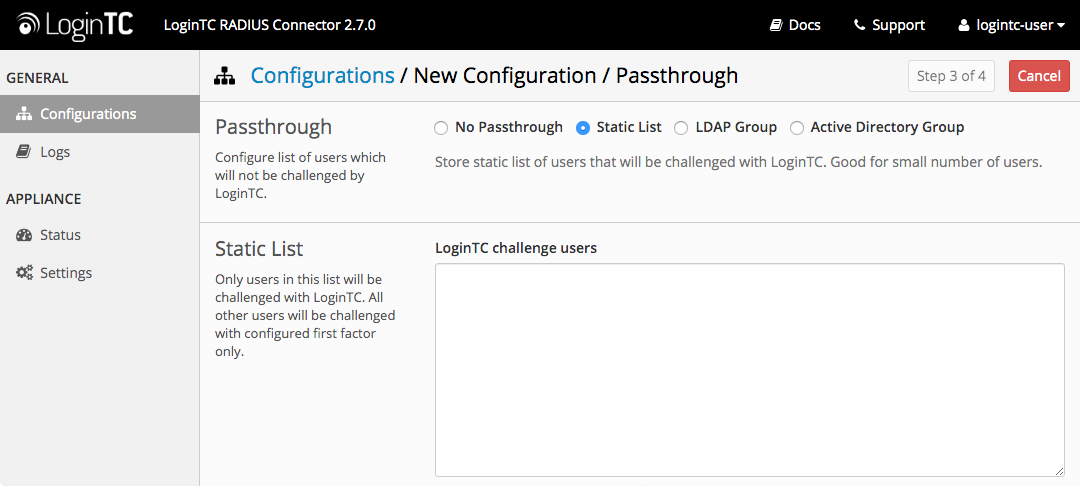
LoginTC challenge users: a new line separated list of usernames. For example:
jane.doe
jane.smith
john.doe
john.smith
Active Directory / LDAP Group
Select this option if you wish to have only users part of a particular Active Directory or LDAP group to be challenged with LoginTC. Good for medium and large number of users.
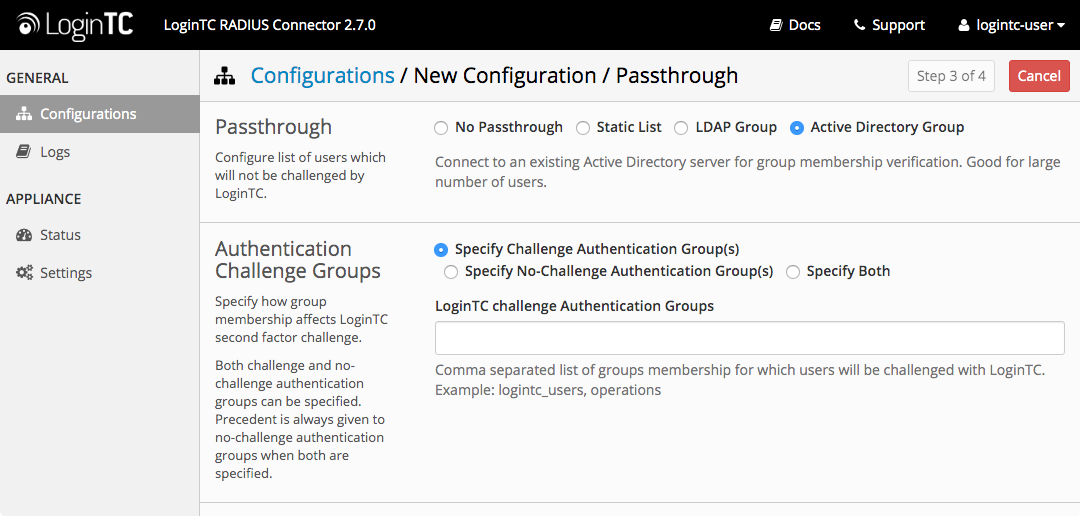
Configuration values:
| Property | Explanation | Examples |
|---|---|---|
LoginTC challenge auth groups |
Comma separated list of groups for which users will be challenged with LoginTC | Office VPN or two-factor-users |
host |
Host or IP address of the LDAP server | ldap.example.com or 192.168.1.42 |
port (optional) |
Port if LDAP server uses non-standard (i.e., 389/636) |
4000 |
bind_dn |
DN of a user with read access to the directory | cn=admin,dc=example,dc=com |
bind_password |
The password for the above bind_dn account | password |
base_dn |
The top-level DN that you wish to query from | dc=example,dc=com |
attr_username |
The attribute containing the user’s username | sAMAccountName or uid |
attr_name |
The attribute containing the user’s real name | displayName or cn |
attr_email |
The attribute containing the user’s email address | mail or email |
encryption (optional) |
Encryption mechanism | ssl or startTLS |
cacert (optional) |
CA certificate file (PEM format) | /opt/logintc/cacert.pem |
Configuration Simplified
If Active Directory / LDAP Option was selected in First Authentication Factor the non-sensitive values will be pre-populated to avoid retyping and potential typos.
Click Test to validate the values and then click Next.
Client and Encryption
Configure RADIUS client (e.g. your RADIUS-speaking VPN):
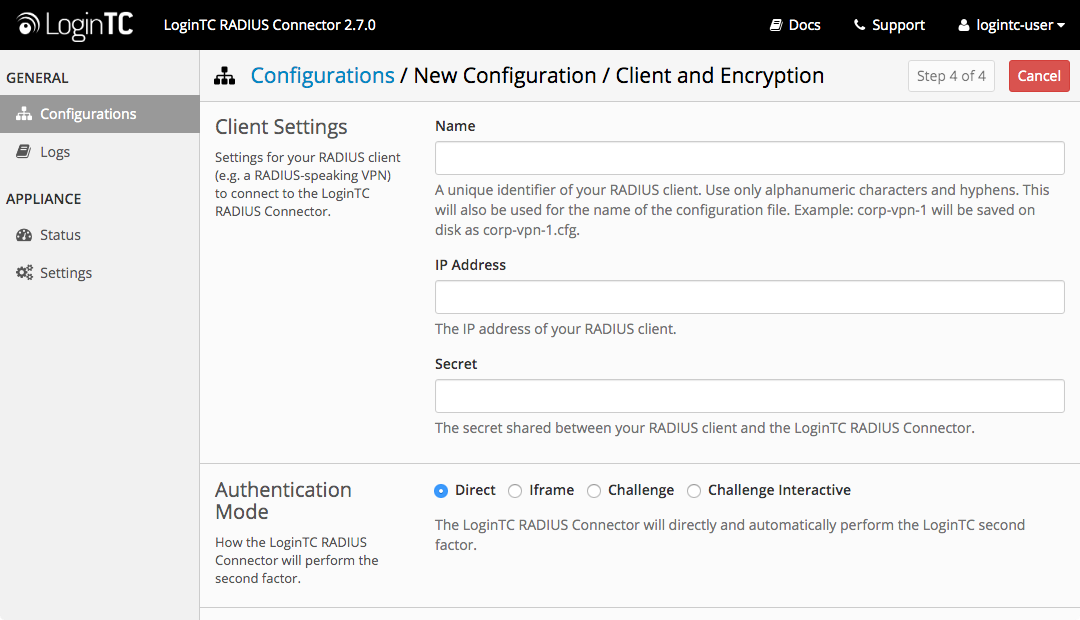
Client configuration values:
| Property | Explanation | Examples |
|---|---|---|
name |
A unique identifier of your RADIUS client | CorporateVPN |
ip |
The IP address of your RADIUS client (e.g. your RADIUS-speaking VPN) | 192.168.1.44 |
secret |
The secret shared between the LoginTC RADIUS Connector and its client | bigsecret |
Under Authentication Mode select Challenge
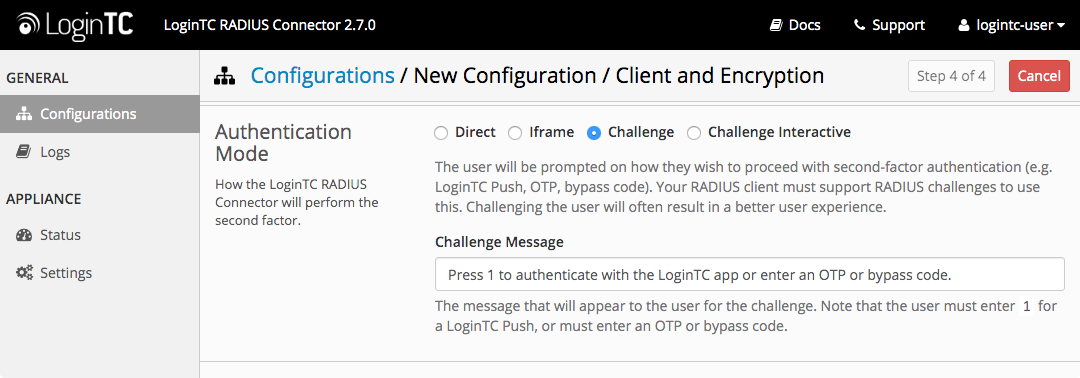
The user will be prompted on how they wish to proceed with second-factor authentication (e.g. LoginTC Push, OTP, bypass code). Your RADIUS client must support RADIUS challenges to use this. Challenging the user will often result in a better user experience. See User Experience for more information.
Data Encryption
It is strongly recommended to enable encryption of all sensitive fields for both PCI compliance and as a general best practice.
Click Test to validate the values and then click Save.

When you are ready to test your configuration, create a LoginTC user (if you haven’t already done so). The username should match your existing user. Provision a token by following the steps:
- In a new tab / window log into the LoginTC Admin Panel
- Click Domains
- Click on your domain
- Click on Members
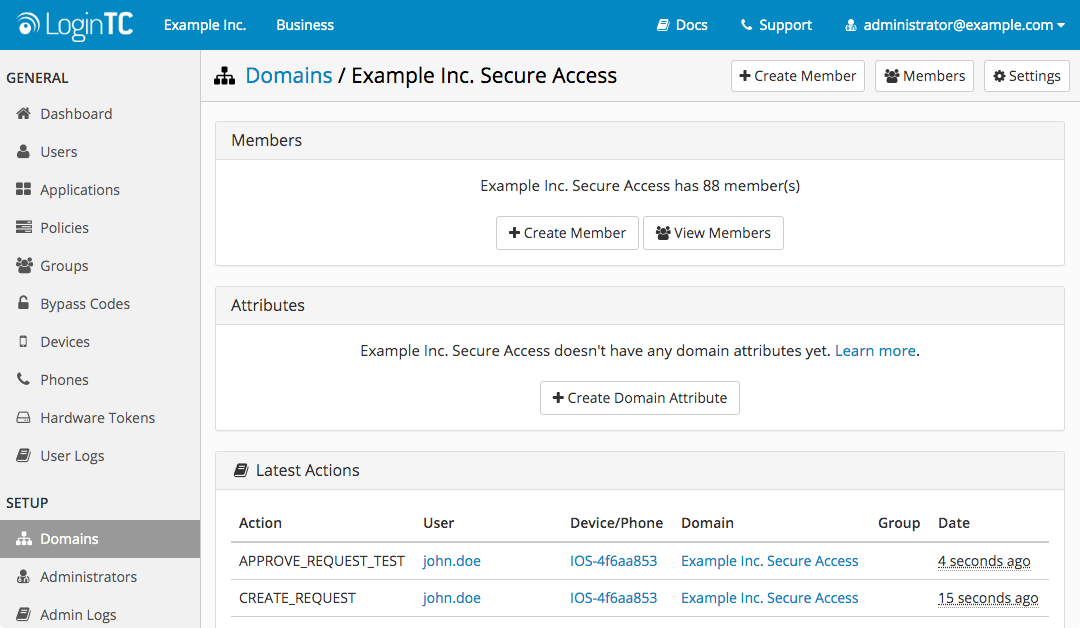
- Click Issue Token button beside your user:
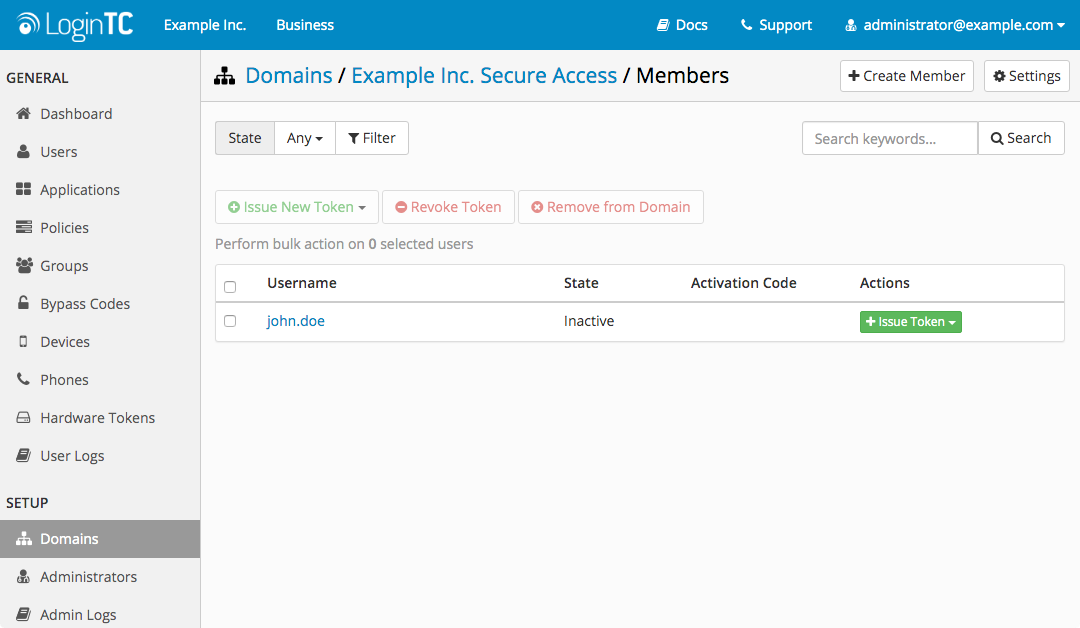
- A 10-character alphanumeric activation code will appear beside the user:
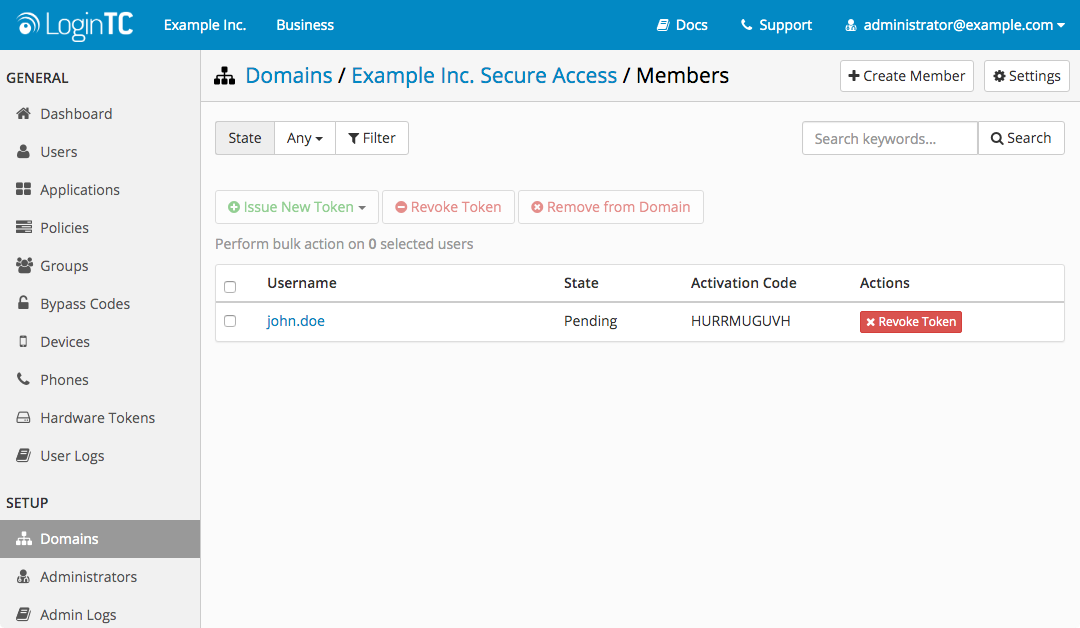
- Open the LoginTC mobile app.
- Enter the 10-character alphanumeric activation code:
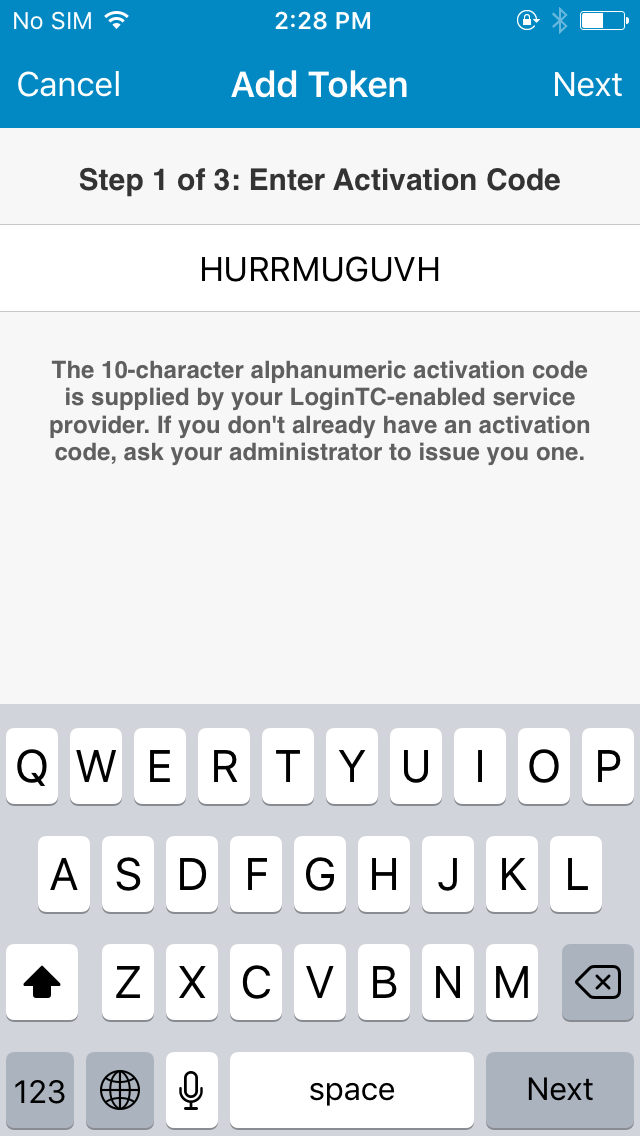
- Load the token to complete the process
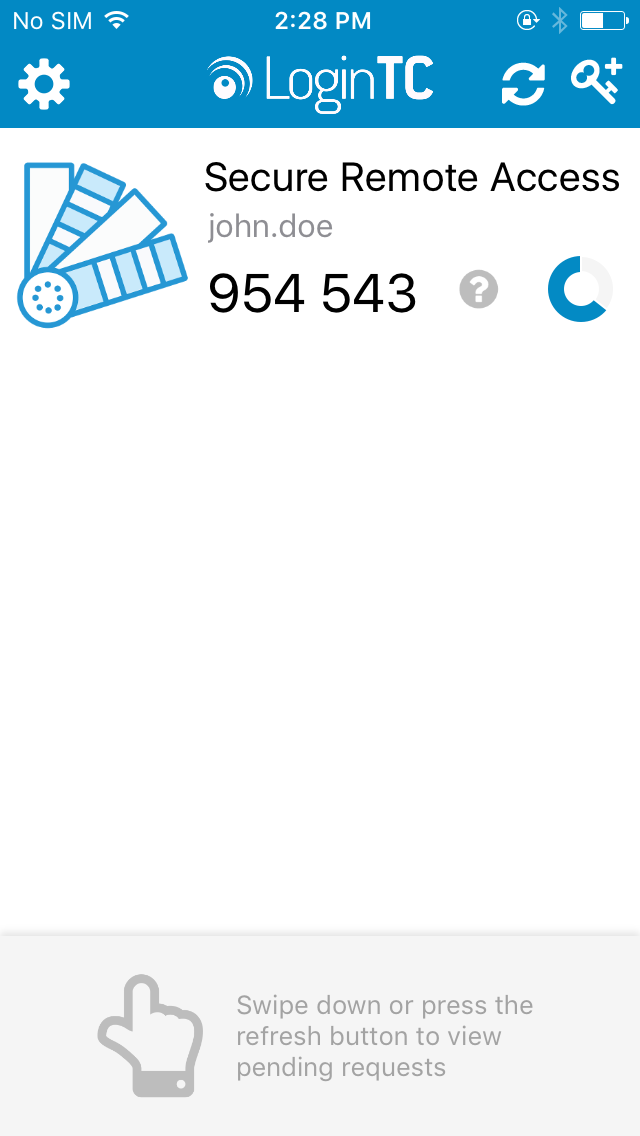
When you have loaded a token for your new user and domain, navigate to your appliance web interface URL:

Click Test Configuration:
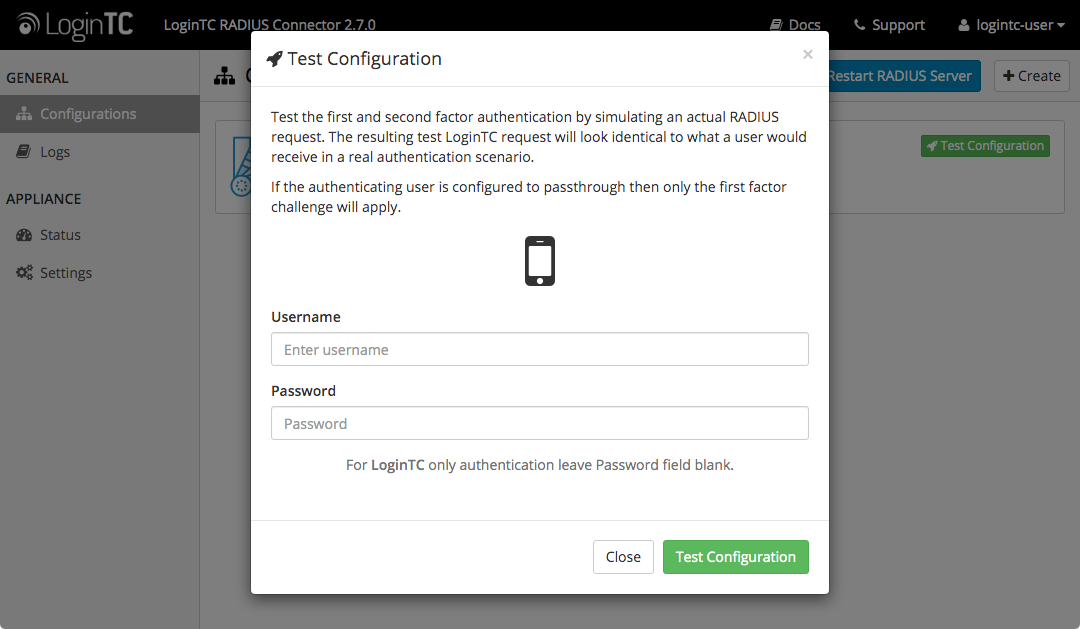
Enter a valid username and password; if there is no password leave it blank. A simulated authentication request will be sent to the mobile or desktop device with the user token loaded. Approve the request to continue:
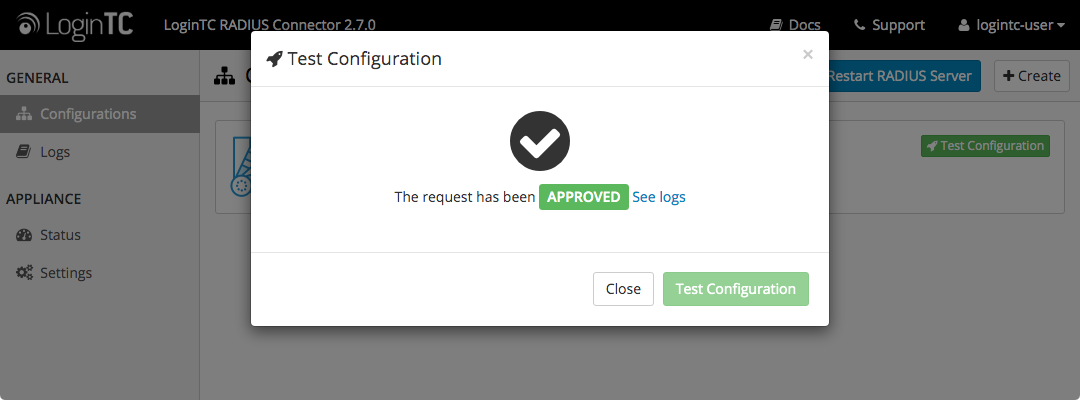
Congratulations! Your appliance can successfully broker first and second factor authentication. The only remaining step is to configure your RADIUS device!
If there was an error during testing, the following will appear:
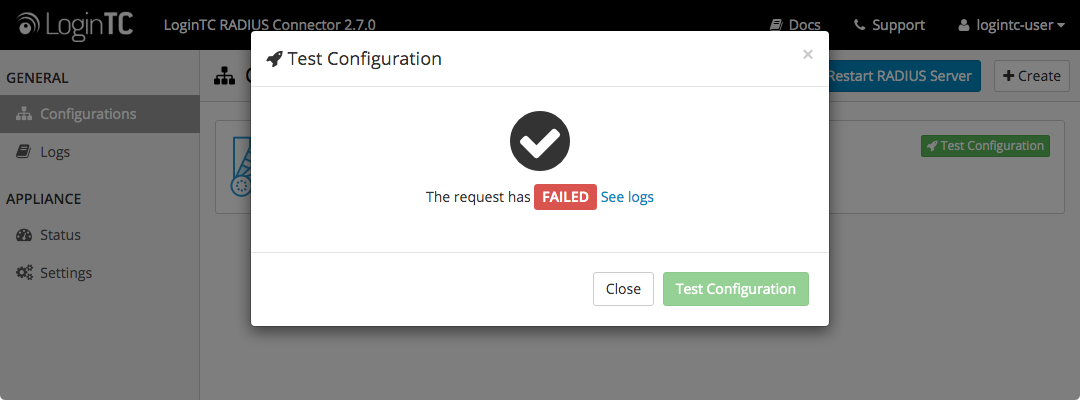
In this case, click See logs and then click the /var/log/logintc/authenticate.log tab to view the log file and troubleshoot:
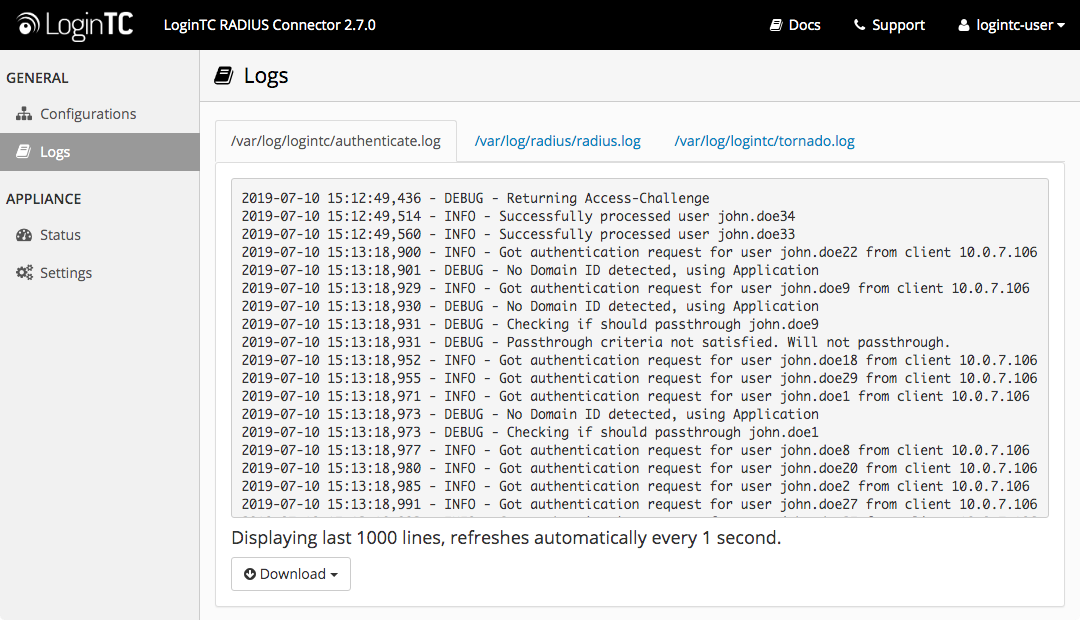
Once you are satisfied with your setup, configure your WatchGuard to use the LoginTC RADIUS Connector.
For your reference, the appliance web interface Settings page displays the appliance IP address and RADIUS ports:
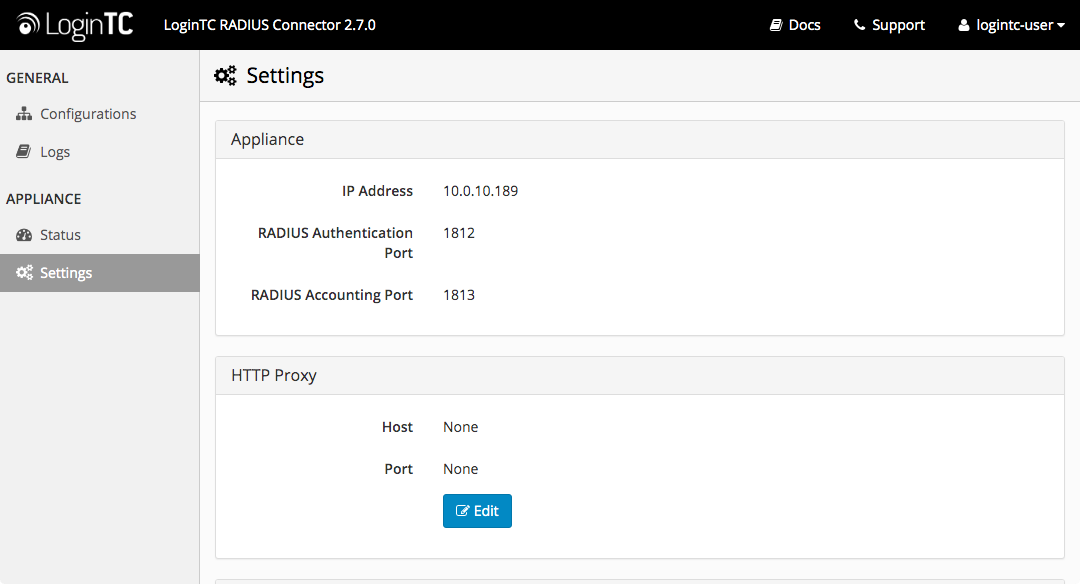
The following are quick steps to get VPN access protected with LoginTC. The instructions can be used for existing setups as well. Although these were performed on WatchGuard Fireware XTM Web UI, the same is true for other devices in the XTM series.
Mobile VPN with IPsec
- Log in to your WatchGuard (Fireware XTM Web UI)
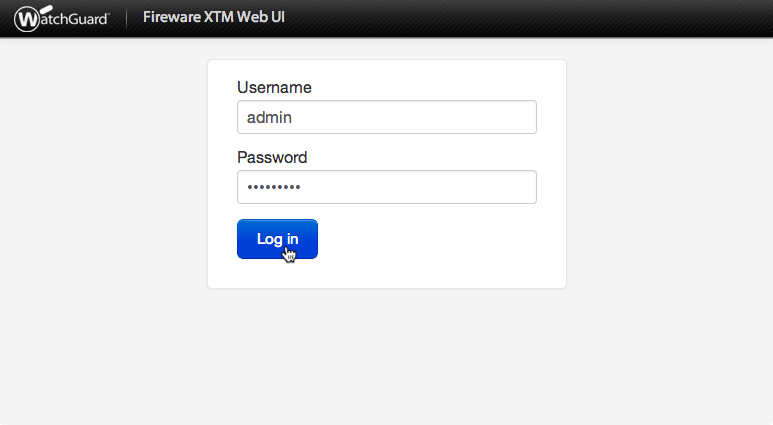
- Click Authentication:
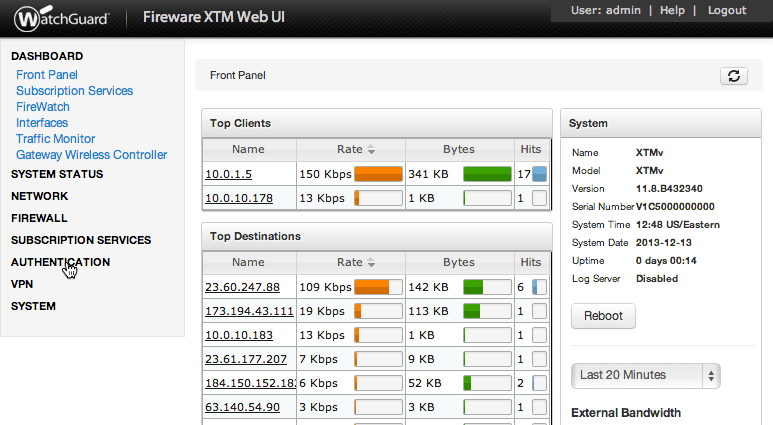
- Under Authentication click Servers:
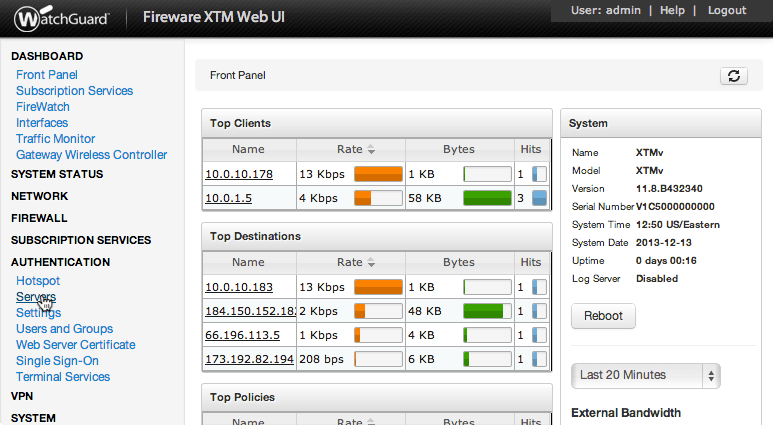
- Under Authentication Servers click RADIUS:
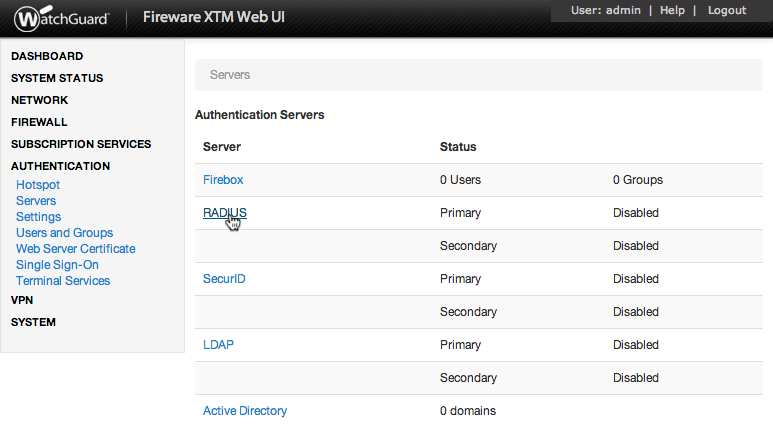
- Under Primary Server Settings click Enable RADIUS Server:
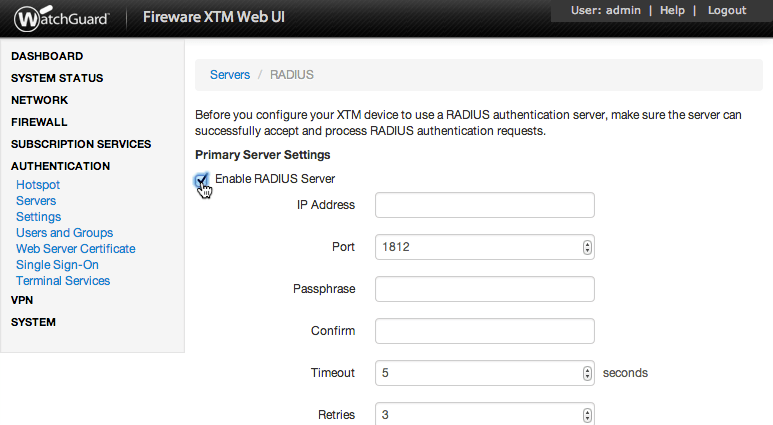
- Complete Primary Server Settings form:
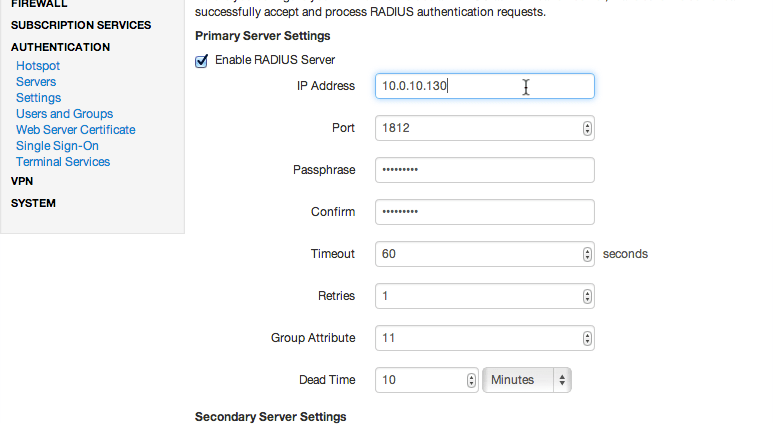
Property Explanation Example IP AddressAddress of LoginTC RADIUS Connector 10.0.10.130 PortRADIUS authentication port. Must be 1812. 1812 PassphraseThe secret shared between the LoginTC RADIUS Connector and its client bigsecret ConfirmThe secret shared between the LoginTC RADIUS Connector and its client bigsecret TimeoutAmount of time in seconds to wait. At least 90s. 90 RetriesAmount of times to retry authentication. Must be 1. 1 Group AttributeRADIUS Attribute to be populated with user group info. Must be 11 when using SSL. 11 Dead TimeAmount of time an unresponsive RADIUS server is marked as inactive 0
Group Attribute and Access Control
WatchGuard devices can use the Group Attribute value to set the attribute that carries the User Group information. This information is used for access control by certain VPN protocols.
If you are using multiple VPN protocols (such as SSL) then you may need to set the value to match their requirements.
- Click VPN:
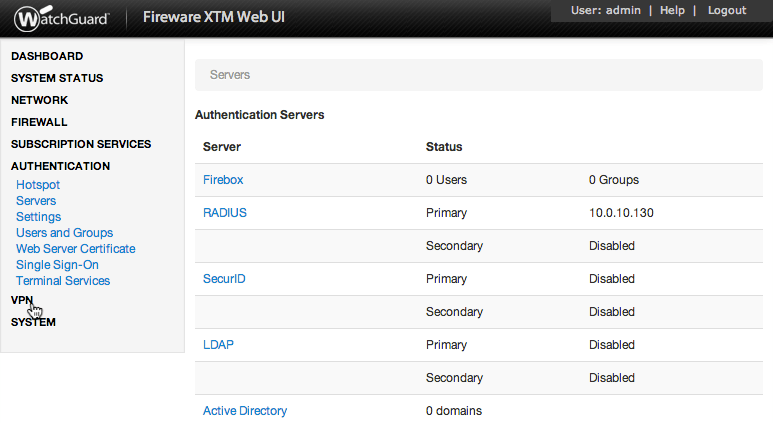
- Under VPN click Mobile VPN with IPsec
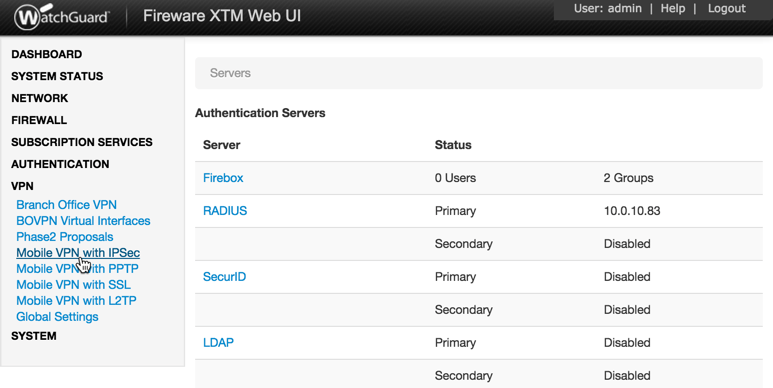
- Click Add to create a new group. Note that the name of the group does not have to match any of the groups names in the LDAP Directory
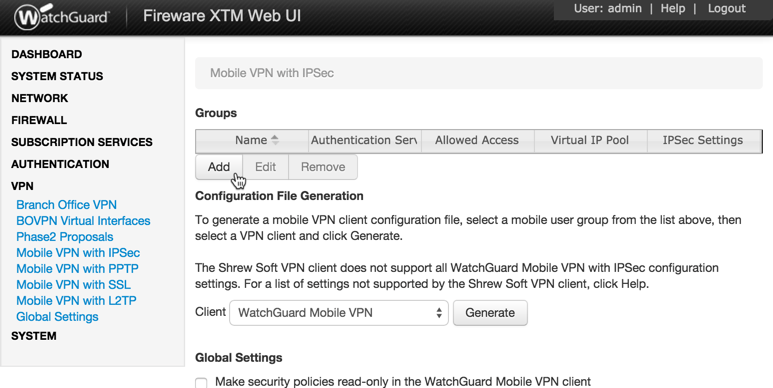
- In General Settings, complete the form and select RADIUS as the authentication server.
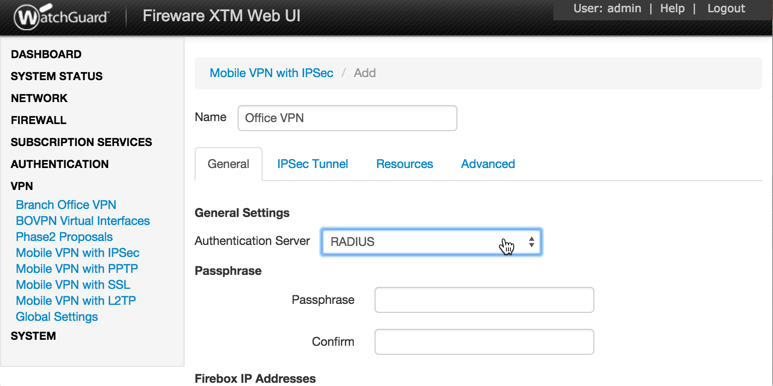
Property Explanation Example NameA unique name for this group configuration. This name must match exactly the LDAP / AD group name configured in First Factor authentication Group Attribute (advanced). Office VPN Authentication ServerThe type of device that users of this group will be authenticated with. Radius PassphraseThe secret shared between the Mobile VPN client and the RADIUS server. The secret must be provided to all IPsec users. sharedsecret ConfirmThe secret shared between the Mobile VPN client and the RADIUS server. sharedsecret PrimaryPrimary IP address or domain name Firebox users connect to. 10.0.10.130 Backup(optional)Secondary IP address or domain name Firebox users connect to. 10.0.10.131
Mobile VPN with IPSec group profile name
In order to use Mobile VPN with IPSec, the Mobile VPN with IPSec group profile name must match exactly the LDAP / AD group name configured in First Factor authentication Group Attribute (advanced).
- Fill out the forms under the IPsec Tunnel, Resources, and Advanced tabs to match the settings of your client. For more information about IPsec client configurations, check the WatchGuard Documentation
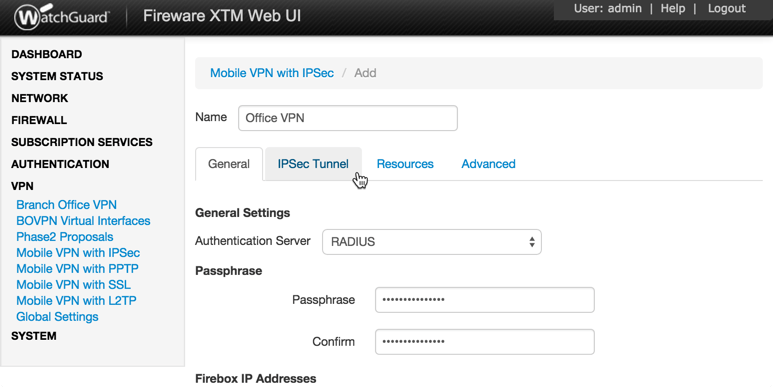
- Click Save

You are now ready to test your configuration.
To test IPsec connections, use an IPsec VPN client such as the WatchGuard Mobile Application.
User ManagementThere are several options for managing your users within LoginTC:
- Individual users can be added manually in LoginTC Admin Panel
- Bulk operations using CSV Import
- Programmatically manage user lifecycle with the REST API
- One-way user synchronization of users to LoginTC Admin is performed using User Sync Tool.
WatchGuard devices have built-in settings that make it easy to configure a secondary RADIUS server to provide failover.
After three authentication attempts fail, Fireware XTM uses the secondary RADIUS server for the next authentication attempt. If the secondary server also fails to respond after three authentication attempts, Fireware XTM waits for the Dead Time interval (10 minutes by default) to elapse. After the Dead Time interval has elapsed, Fireware XTM tries to use the primary RADIUS server again.
To set up another RADIUS server, deploy the downloaded LoginTC Connector again (you can deploy it multiple times) and configure it using the same settings as the first one. Click here to review the Connector configuration process. Afterwards, login to your WatchGuard Web UI and make the following changes:
- Select Authentication from the left-hand navigation bar
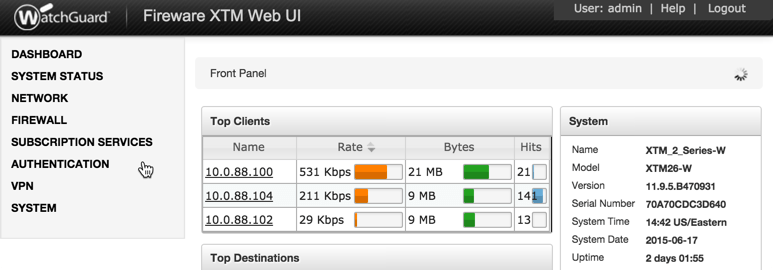
- Click Servers
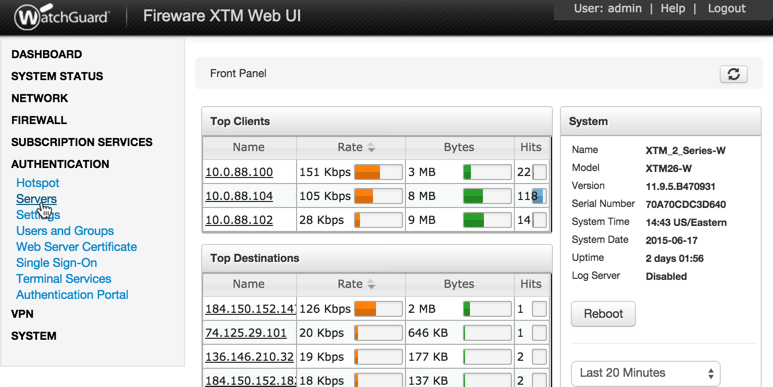
- Select RADIUS
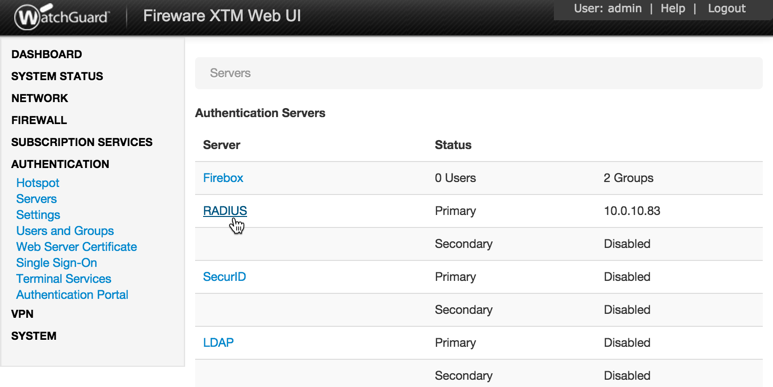
- Check the box to Enable Secondary RADIUS Server
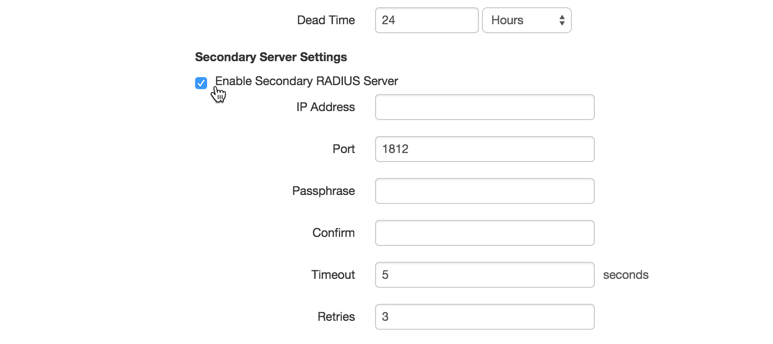
- Complete the Secondary Server Settings Form using the same settings as the primary one
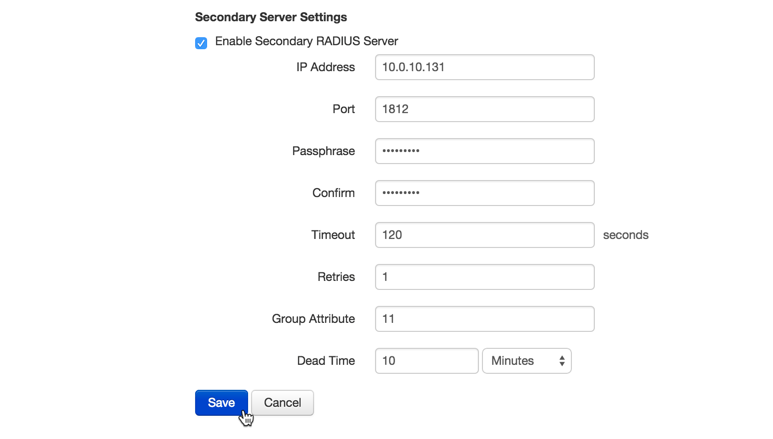
Property Explanation Example IP AddressAddress of Secondary LoginTC RADIUS Connector 10.0.10.131 PortRADIUS authentication port. Must be 1812. 1812 PassphraseThe secret shared between the LoginTC RADIUS Connector and its client newsecret ConfirmThe secret shared between the LoginTC RADIUS Connector and its client newsecret TimeoutAmount of time in seconds to wait. Must be at least 10 seconds longer than the LoginTC Request Timeout. 70 RetriesAmount of times to retry authentication. Must be 1. 1 Group AttributeRADIUS Attribute to be populated with user group info. Must be 11. 11 Dead TimeAmount of time an unresponsive RADIUS server is marked as inactive before the WatchGuard device attempts to connect to it again 10 - Click Save

Logs can be found on the Logs tab:

User Receives Multiple LoginTC Requests
See the Knowledge Base articles:
- My WatchGuard SSL VPN users receive multiple LoginTC requests. What can I do?
- My WatchGuard IPSec VPN users receive multiple LoginTC requests. What can I do?
Authentication times out
See the Knowledge Base articles:
- My WatchGuard SSL VPN users receive multiple LoginTC requests. What can I do?
- My WatchGuard IPSec VPN users receive multiple LoginTC requests. What can I do?
No Network Connection
- First ensure that your LoginTC RADIUS Connector is configured to have a virtual network adapter on
eth0 - Ensure that the virtual network adapter MAC address matches the one in the file
/etc/sysconfig/network-scripts/ifcfg-eth0 - Restart the networking service:
service network restart - If you notice the error that
eth0is not enabled, then check driver messages for more information:dmesg | grep eth - It’s possible that the virtualization software renamed the network adapter to
eth1. If this is the case, rename/etc/sysconfig/network-scripts/ifcfg-eth0toifcfg-eth1.mv /etc/sysconfig/network-scripts/ifcfg-eth0 /etc/sysconfig/network-scripts/ifcfg-eth1Open the file and update the
DEVICE="eth0"line toDEVICE="eth1"
Not Authenticating
If you are unable to authenticate, navigate to your appliance web interface URL and click Status:
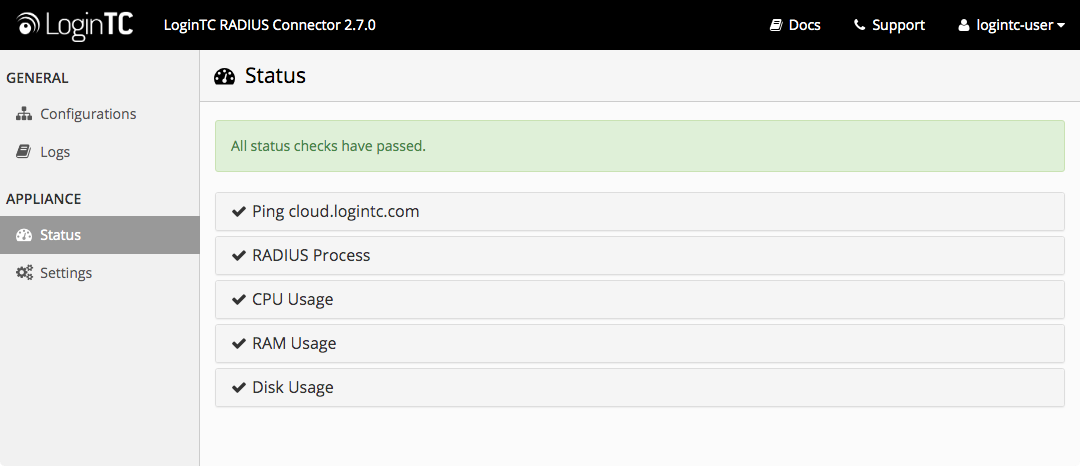
Ensure that all the status checks pass. For additional troubleshooting, click Logs:

Unsuccessful authentication may be caused by premature timeouts
If you have activated Mobile VPN with SSL, check that your Group Attributes are configured correctly.
Email Support
For any additional help please email support@cyphercor.com. Expect a speedy reply.
Incorrect Group Settings
If you are using a Mobile VPN protocol such as SSL and are unable to authenticate, check that your Group Attributes are configured correctly. Navigate to your WatchGuard Web UI and click Dashboard in the left-hand navigation bar: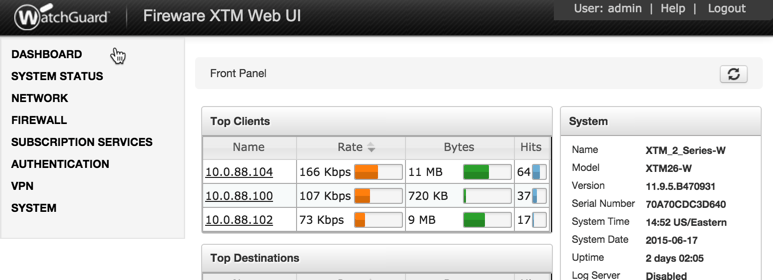
Click on Traffic Monitor: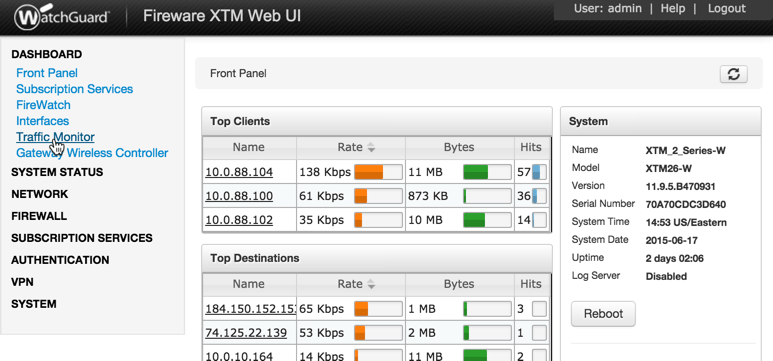
Select Diagnostic from the table header options: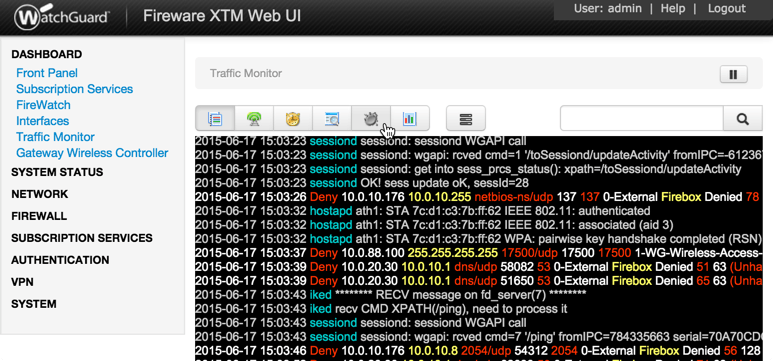
If you can find the following error message then there is a problem with your Group Attribute settings:
2015-XX-XX 16:52:41 admd Authentication failed: user username@RADIUS isn't in the authorized SSLVPN group/user list!
Search for the following error message:
2015-XX-XX 16:59:52 admd RADIUS: no attribute-value pair is retrieved from packet
If found, it means that the RADIUS Connector is not sending back any Group Attribute information. Navigate to your appliance web interface and click Configurations. Select the domain you’re having problems with: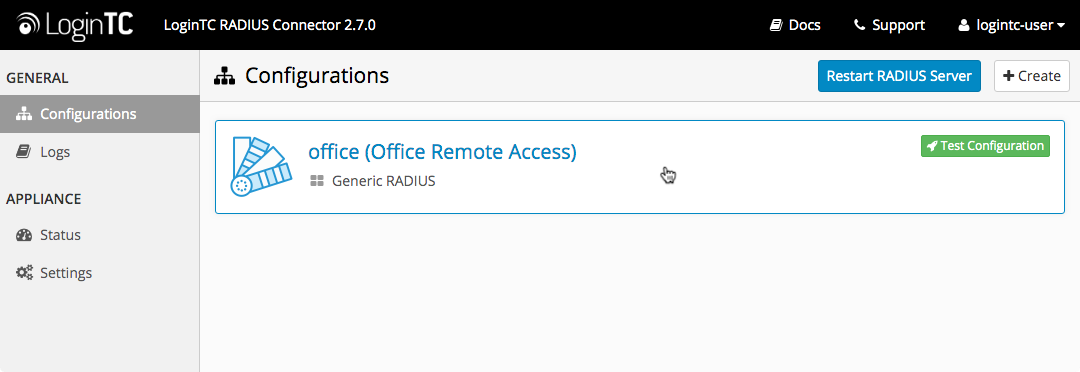
Click the Edit Button in the First Factor section: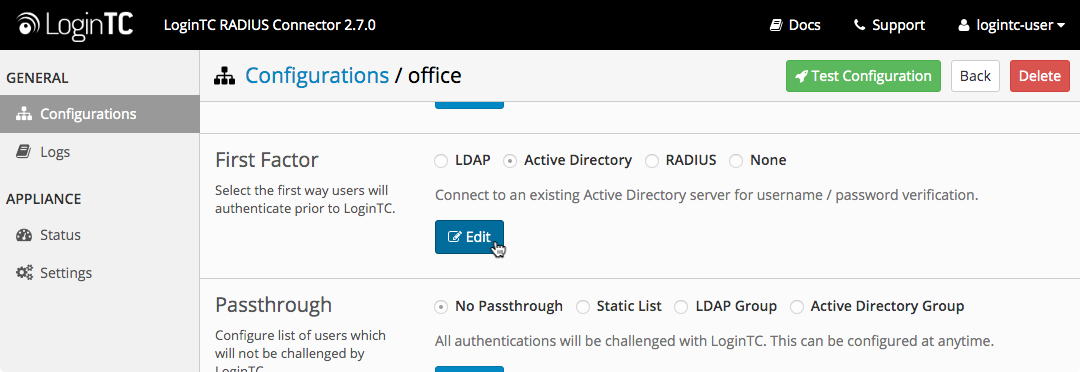
Scroll down to the to the Group Attribute section:
- If “None” is selected, change it to “Specify a group attribute”. Click here to review how to configure the Group Attribute for SSL
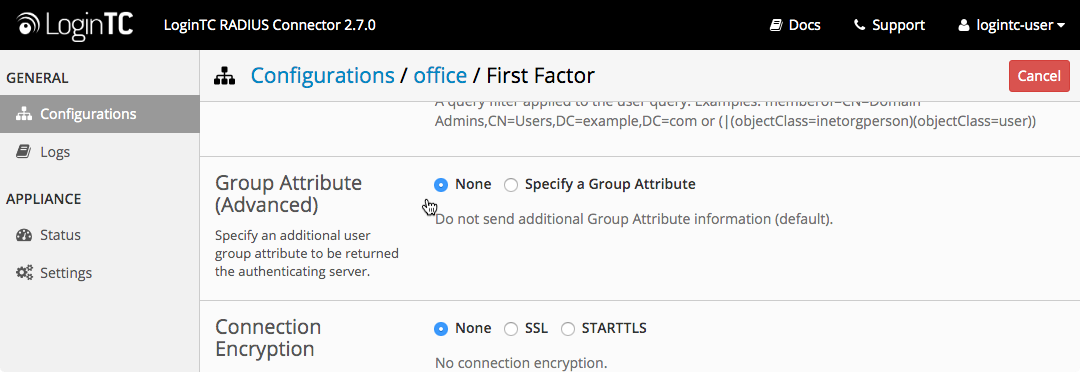
- Otherwise, check that your user is a member of the specified group in the LDAP Directory. If they are not, it will cause RADIUS to return a blank attribute.
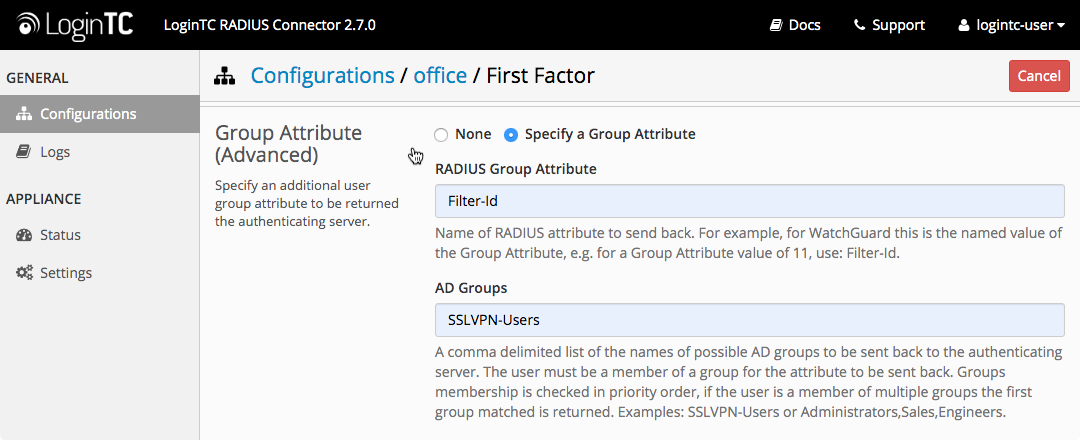
If you find a log message similar to this:
2015-XX-XX 16:52:41 admd RADIUS: finished parsing attribute-value pairs
2015-XX-XX 16:52:41 admd RADIUS: group 1, type=11 value=L2TP-Users
2015-XX-XX 16:52:41 admd RADIUS: retrieve VP:Filter-Id(11) int=10
Then the RADIUS server is sending back a Group Attribute, but it may not be the correct one.
Check that the value is the name of the group that has been added to list of groups authorized to authenticate with SSL. Log into the WatchGuard Web UI and select VPN from the left-hand navigation bar. Click on Mobile VPN with SSL :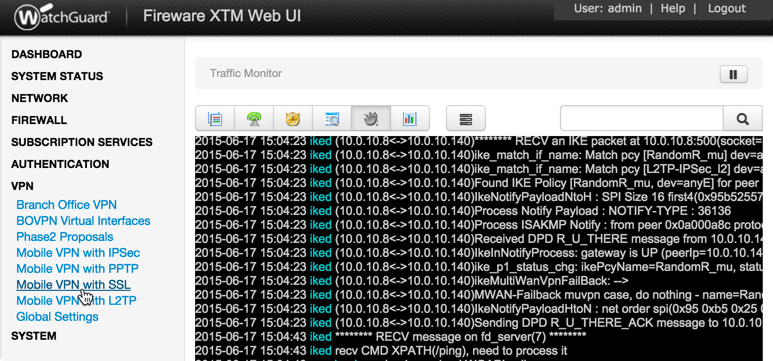
Click on the Authentication tab: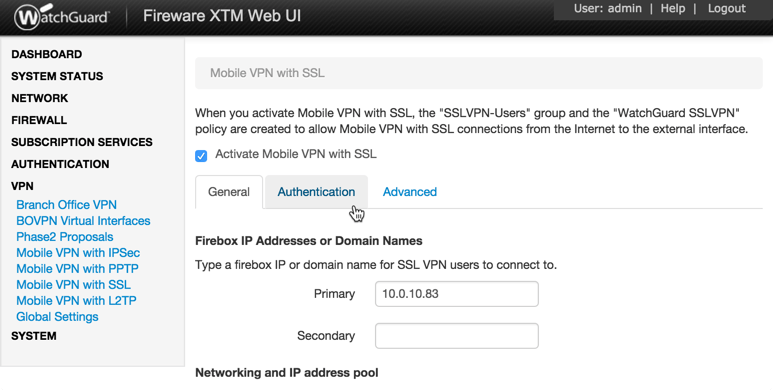
The bottom table contains the list of groups that are authorized to connect with SSL. If the group returned by the RADIUS server is not part of it, it must be added. Click the Add button:
Type in the group name and select RADIUS as the Authentication Server: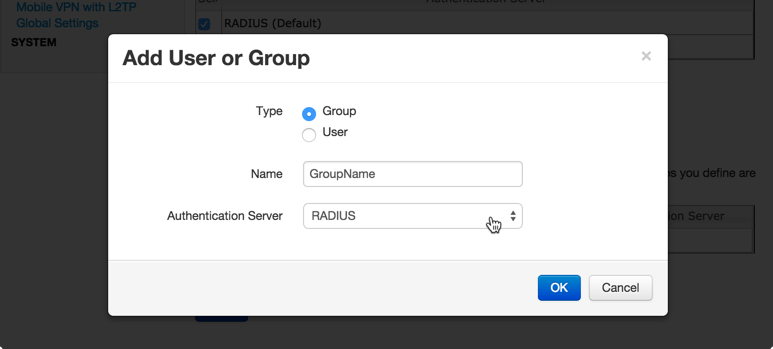
Authentication Timing Out
If authentication is failing, it is possible that the authentication requests are timing out too quickly. By default, LoginTC push requests will timeout after 90 seconds. Another timeout value is defined by the RADIUS server configuration. If it is set too low, it will cause requests to prematurely timeout. To check, login to your WatchGuard Web UI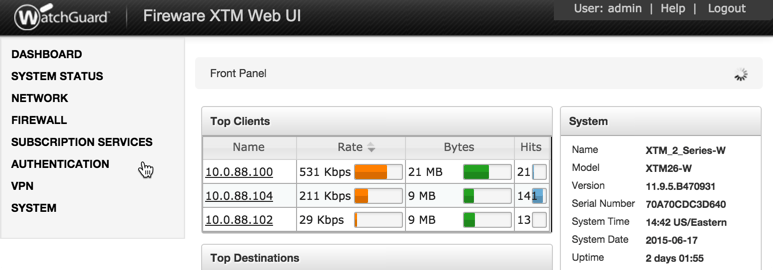
- Select Authentication from the left-hand navigation bar, then click Servers
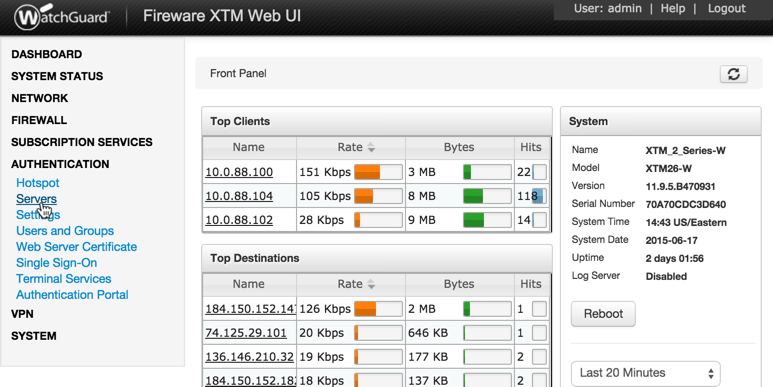
- Click RADIUS
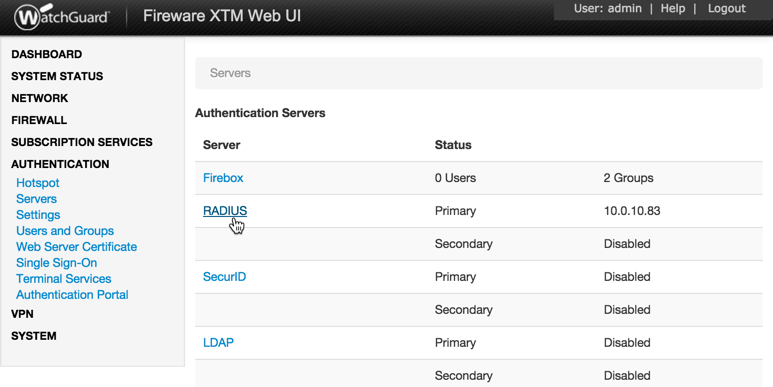
- Check the Timeout attribute field. It should be at least 10 seconds longer than the LoginTC Request Timeout set in the LoginTC RAIDUS Connector.
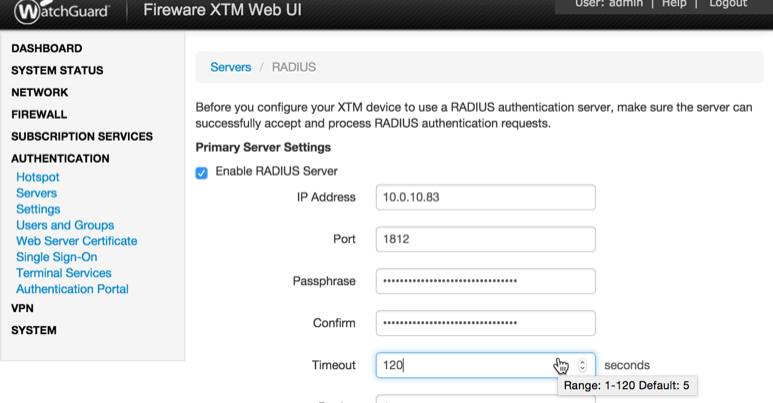
See the Knowledge Base articles for more information:
- My WatchGuard SSL VPN users receive multiple LoginTC requests. What can I do?
- My WatchGuard IPSec VPN users receive multiple LoginTC requests. What can I do?
Email Support
For any additional help please email support@cyphercor.com. Expect a speedy reply.
From 3.X
Follow these instructions to upgrade your LoginTC RADIUS virtual appliance to the latest version (3.0.7):
- SSH into the virtual appliance or open the console (use same username / password as web GUI)
-
cd /tmp -
curl -O https://www.logintc.com/downloads/logintc-radius-connector-3.0.7-upgrade.sh -
sudo sh logintc-radius-connector-3.0.7-upgrade.sh
The upgrade script will restart your appliance after upgrading.
Upgrade Script Download Verification
Execute:
sha1sum /tmp/logintc-radius-connector-3.0.7-upgrade.sh
Output SHA‑1 should match:
631fa21d614a1976e9c6141471878f114e544994
From 2.X
Important: LoginTC RADIUS Connector 2.X End-of-life
The LoginTC RADIUS Connector 2.X virtual appliance is built with CentOS 6.8. CentOS 6.X is End of Lifetime (EOL) November 30th, 2020. Although the appliance will still function it will no longer receive updates and nor will it be officially supported.
New LoginTC RADIUS Connector 3.X
A new LoginTC RADIUS Connector 3.X virtual appliance has been created which runs CentOS 7.7.1908. It is virtually identical to the existing appliance, with the exception of the underlying operating system. Inline upgrade from CentOS 6.X to CentOS 7.X is not supported. As a result upgrade is deploying a new appliance. A migration script has been created to help quickly copy over existing configurations and ssl certificates to the new appliance and minimize manual steps.
Complete 2.X to 3.X upgrade guide: LoginTC RADIUS Connector Upgrade Guide
Additional Resources